The Tree of Life

Andites. Inanna. Maya.
There is also a link to it at the bottom of this page.
So, our story starts with the Andites as a pure Mesopotamian story. I wish I could say the Adamites and the Nodites only lived in what would later become Sumeria but nothing's that simple. Actually, one of Adam and Eve's sons - Adamson a pure line Adamite - met and married one of the last pure Nodite women and founded what I call the third Garden of Eden. This "third Eden" was located in the foothills of the Kopet Dagh where Van had lived all those millennia. Van's headquarters are also west of Bactria namesake to the BMAC the Bactria Margianna Archaeological Complex, the Oxus civilization and west of the future Indus Valley civilization. This area also became a hub for the silk road. A great location for the the dispersal of culture south into India, east into China and west into future Europe. The Urantia Book defines these people as a race which have been long absorbed to the various peoples of today. Too bad. They were humorous, artistic, adventurous, inventive and musical. They gave us everything they had. They gave us civilization.
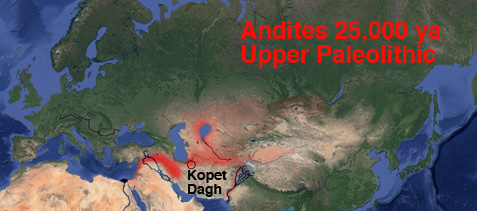 The
Birth of the Andites
The
Birth of the Andites"The earliest Andite peoples took origin in the regions adjacent to Mesopotamia more than twenty-five thousand years ago and consisted of a blend of Adamites and Nodites." (Urantia Book p. 871)
The Andites became a people in the area, mostly mountainous, that surrounds Mesopotamia. They are a mixture of three bloodlines, the Adamic, Nodite and indigenous natives and were the newest race on the planet. When they started migrating it was first to the east and was the start of a vast movement that would last for almost twelve thousand years.
The Kopet Dagh, the location of the "3rd Eden", was the home of Adamson and Ratta. This is a secondary location for the earliest eastern and northern expansion of the Andites. These pre-date the Mesopotamian Andites by about 15,000 years being of the extended family of Adamson and Ratta. This map has the Andites along the Oxus River and about the Aral Sea, a huge inland fresh water lake which would have invited any number of animals. The Andites as a whole are one of the most important races (unknown to moderns) to have an impact on civilization. As you can see by the map their main origin was on the margins of Mesopotamia. To the west was the Levantine corridor, to the north they lived in northern Iraq and Syria and to the east the Zagros mountains. For an in depth explanation of who the Andites are see page The First Legend Introduction. The link is at the bottom of this page.
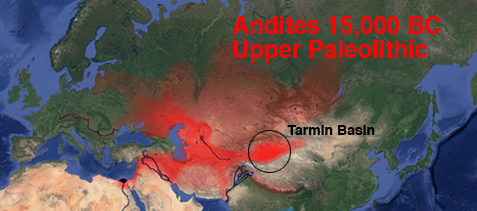 Second Migration
of the Andites
Second Migration
of the AnditesIt was about 15,000 B.C. when a great renaissance of the Garden culture was carried out to Eurasia. At this time a first wave of hunter gatherer Andites had migrated east as far as the Tarmin Basin making contact with the Chinese. Some were heading north along the Caspian to enter Europe. And others drifted south to finally enter India. These were not warrior type conquests but rather more based on resettlement and trade.
"Later on, when the migrating Adamites and Nodites entered the then fertile regions of Turkestan [now Turkmenistan], they soon blended with the superior inhabitants, and the resultant race mixture extended the Andite type northward." (Urantia Book p. 871-2) "From Mesopotamia through Sinkiang [now known as the Tarmin Basin] the Andite culture was dominant, and the steady migration toward Europe was continuously offset by new arrivals from Mesopotamia. ...The civilization of Turkestan was constantly being revived and refreshed by the newcomers from Mesopotamia, especially by the later Andite calverymen. The so-called Aryan mother tongue was in the process of formation in the highlands of Turkestan; it was a blend of the Andonic dialect of that region with the language of the Adamsonites and later Andites. Many modern languages are derived from this early speech of these central Asian tribes who conquered Europe, India, and the upper stretches of the Mesopotamian plains. This ancient language gave the Occidental tongues all of that similarity which is called Aryan." (Urantia Book p. 872) In this age of political correctness this tongue is now called Indo-European.
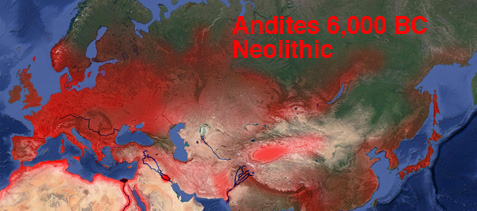 Last Migrations
of the Andites
Last Migrations
of the Andites"By 12,000 B.C. three quarters of the Andite stock of the world was resident in northern and eastern Europe, and when the later and final exodus from Mesopotamia took place, sixty-five per cent of these last waves of emigration entered Europe." (Urantia Book p. 872-3)
"The migratory conquests of the Andites continued on down to their final dispersions, from 8000 to 6000 B.C....They were skillfull domesticators of animals and expert agriculturists. For the time being, at least, their presence usually improved the religious beliefs and moral practices of the older races." (Urantia Book p.873)
These final migrations from Mesopotamia went north in their largest number via the Caspian sea. Of this northern trek a small number went east into the Tarmin Basin with another small group went east into today's Iran. Yet another small group went southwest to Egypt. Only five per cent remained in the southern most part of Mesopotamia but these culturally superior Andites would become the seed of the later appearing Sumerians. These were the last of the Andite migrations for at about 8,000 BC a drough arose in Central Asia and the Andites were dispersed from it. Some came back to northern Mesopotamia others headed into Europe, Iran, Egypt and India.
It should be remembered when looking at these maps that as the Andites spread out from Mesopotamia, that early man collectively was already there having had over half a million years to populate these lands. There was a continual movement of Andites from Mesopotamia and all evidences of civilization were carried from the epicenter of the Garden of Eden and Nodite culture. In these migrating waves were the Sethite priests who were taught by Seth one of the sons of Adam and Eve. I think it would be fair to attribute an influence of these fables, gods and history of Eden to these Sethite priests. So Andite culture was being overlaid atop the old Paleolithic stone age culture, uplifting and advancing it in preparation for the coming of civilization. And the Andite's inventiveness did not halt until after civilization appeared and they were quietly absorbed into the many faces of mankind. With the passing of the Andites no longer would the bloodline of the Adamites and Nodites be available to up step the peoples of the planet.
(Chick here to return to First Legend page.)
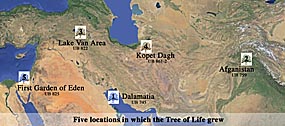 Locations of
the Tree of
Life
Locations of
the Tree of
Life
The
image to the left shows the five locations where the Tree of Life
may have grew. The first is in the then dry Persian Gulf south of what would
become
Mesopotamia. It is where the celestials first touched down. It was here
they built the first city of Dalamatia that the Andites
would later build Dilmun in remembrance. The
Tree of Life was brought to the planet with the prince’s
arrival. The fruit of the tree was sustenance for the 100 materialized
members and the 100 modified Andonites. When
eaten it could extend
indefinitely their mortal existence. When the Lucifer
rebellion broke out,
loyal cherubim and seraphim took possession of it and allowed only the
loyalist to partake of its fruit and leaves. When Van and Amadon left
for the
northern part of Afghanistan, "the highlands west of
India" they
took the tree, or most likely a cutting, with
them and began to guard it
for the next 150,000 years. But they did not stay in this
part of southeastern Central Asia. At some point they moved to a new
location near
Lake Van. Eventually Van and Amadon moved to his headquarters in the
Kopet Dagh.
With
the coming of Adam and Eve the Tree was finally planted in the first
Garden of Eden where it would be destroyed after the Adamic couple left
for the second garden. Eventually the entire Edenic peninsula was
destroyed by a major earthquake that shook the entire region and was
pulled under the flooding waters of the Mediterranean basin.
"Adamson
was among that group of children of Adam and Eve who elected to remain
on earth with their father and mother. Now this eldest son of Adam had
often heard from Van and Amadon the story of their highland home in the
north, and sometime after the establishment of the second garden he
determined to go in search of this land of his youthful dreams...
A company of twenty-seven followed Adamson northward in
quest of these people of his childhood fantasies. In a little over
three years Adamson's party actually found the object of their
adventure, and among these people he discovered a wonderful and
beautiful woman, twenty years old, who claimed to be the last pure-line
descendant of the Prince's staff. This woman, Ratta, said that her
ancestors were all descendants of two of the fallen staff of the
Prince." (Urantia Book p. 861)
"The Adamonites
maintained a high culture for almost seven thousand years from the
times of Adamson and Ratta. Later on they became admixed with the
neighboring Nodites and Andonites and were also included among the
"mighty men of old." And some of the advances of that age persisted to
become a latent part of the cultural potential which later blossomed
into European civilization.
This center of civilization was situated in the
region east of the southern end of the Caspian Sea, near the Kopet
Dagh. A short way up in the foothills of Turkestan are the vestiges of
what was onetime the Adamsonite headquarters of the violet race."
(Urantia Book p. 862)
So, much later the tree would finally be replanted from the Kopet Dagh area to the peninsula where the first Garden of Eden was located. It took only 105 years for the Garden's demise. After the default, Adam and Eve were not allowed to carry the tree to the second garden. The tree was now unprotected at this time and burned by Nodites warring among themselves. Since the system circuits were now suspended, they were unable to benefit from the age defying properties of its fruit. With this destruction of the Tree of Life no longer would any personality be able to suspend the natural course of mortal existence. Scholars suspect that the Garden of Eden was located between the Tigris and Euphrates rivers. That is partially correct. It was the location of the second Garden that Adam and Eve created by the sweat of their brow after their default. Because of close locations of these three epical events - the arrival of celestials, the Lucifer rebellion and the establishment of the second Garden - and the enormous time frame in which they transpired, these legends became what I call a composite legend.
But the Tree of Life would live on in legend. Its history was part of Andite culture that spread around the world. Even the Mother Earth Goddess and the serpent survived. That is quite remarkable considering the length of time these events took place. Even now in the twenty first century these three icons from our distant past are still common knowledge.

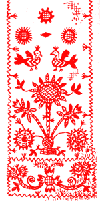
 Art,
Language and Culture
Art,
Language and CultureOne of the earliest settlements of mankind is the Cucuteni-Trypillian culture in Moldova, Romania and the Ukraine (the earliest we know of is Catalhoyuk, southern Turkey 6200-5700 BC). Located northwest of the Black Sea this area is now being referred to as part of the Old Europe dating back to 5500 BC. This term Old Europe was coined by archaeologist Marija Gimbutas and is synonymous with Neolithic Europe and Pre-Indo-European. Among artifacts unearthed are images of the Tree of Life and the ever pervasive figurines of the Earth Mother. The image of the Tree of Life along with others from the ancient Neolithic are still a part of traditional folk art in this region today. Click on bowl for a larger image.
There are two important things about this culture that marks it as Andite. First is evidence of the domestication of the horse. The Urantia Book states that the Andites were the first to do so. Second are the many goddess figurines found buried through out this region. The Urantia Book also states that the Andites worshiped the Mother Earth goddess. They had a crude and elementary system writing. At least by our standards. Linguists have determined that there are some words related to Sumerian although these early scripts are open to speculation. This script maybe related to the Danube script which at this point is not very well understood. Both of these assumptions are most likely correct. It should be remembered that the neighboring Hungarians believe that they too are related to the Sumerians and that the Hungarian language helped decode and translated the cuneiform tablets. The C-T culture was experimenting with agriculture and metal, copper in particular. "Copper metallurgy was first introduced into east central Europe by 5500 BC, and clearly has a long and relatively unknown pedigree amongst the Old European homelands north of the Black Sea. Linguistically the vocabulary of metallurgy provides some evidence of the antiquity of smelting tradition. Where a root word exists in multiple languages, it is generally accepted as evidence of its antiquity." (http://www.gizagrid.com/egyptian_iron.html © Keith Squires 2005)
 The
worship of the Great Goddess, the Earth Mother, was by the time of
the Neolithic becoming dominated by the male gods. In
Sumeria the goddess became Inanna and remained a potent figure of
worship and power. The veneration of the Tree of Life continued on
finding expression in both stone reliefs and palatial murals. As these
Andites migrated out from the alluvial plains of
the Tigris and Euphrates every culture that grew up in their wake
echoed their reverence for the Tree of Life.
The four above Venuses are Gravettian named after a region in
France. This culture from 28,000 to 22,000
BC is Upper Paleolithic
which includes much of central Europe and Russia. These four are named
from left to right: Venus of
Vestonice Dolni (Czech Republic), Venus of
Willendorf (Vienna, Austria), Venus
of Lespugue (France) and the Venus of Laussel
(Dordogne,
France). All date to after the establishment of Eden.
The
worship of the Great Goddess, the Earth Mother, was by the time of
the Neolithic becoming dominated by the male gods. In
Sumeria the goddess became Inanna and remained a potent figure of
worship and power. The veneration of the Tree of Life continued on
finding expression in both stone reliefs and palatial murals. As these
Andites migrated out from the alluvial plains of
the Tigris and Euphrates every culture that grew up in their wake
echoed their reverence for the Tree of Life.
The four above Venuses are Gravettian named after a region in
France. This culture from 28,000 to 22,000
BC is Upper Paleolithic
which includes much of central Europe and Russia. These four are named
from left to right: Venus of
Vestonice Dolni (Czech Republic), Venus of
Willendorf (Vienna, Austria), Venus
of Lespugue (France) and the Venus of Laussel
(Dordogne,
France). All date to after the establishment of Eden.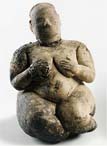

 To
the far left the Goddess from Gobleki Tepe (east of Catalhoyuk)
Anatolia
9,000 B.C.
To
the far left the Goddess from Gobleki Tepe (east of Catalhoyuk)
Anatolia
9,000 B.C.Middle the Goddess from the Halaf period Mesopotamia 7,000 B.C.
To the near left the Goddess from Sumeria, Inanna "Queen of Heaven" 3,000 B.C.
For more information on these sacred statuettes see page The Venus Cult.


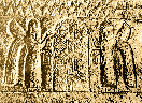 To the
far left the Babylonian
Tree of Life in stone relief Palm style
To the
far left the Babylonian
Tree of Life in stone relief Palm styleMiddle a Sumerian cylinder impression with genii, a god (or goddess), Tree of Life, serpent and the solar winged disk.
To the immediate left the Urartian Tree of Life with attending genii picking the fruit. Click on the image for a larger view.

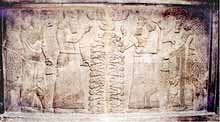
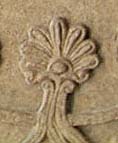 Assyrian
Tree of Life
with two geniis and King Ashurnasirpal.
Assyrian
Tree of Life
with two geniis and King Ashurnasirpal.From the Northwest palace at Nimrud. Click on image for a larger view.
This smaller tan illustration is a detail of one of the leafs or fruit in the Palm style.
The Vanites were the ancestors of the Assyrians (Urantia Book p. 860) whose main religious symbol was the Tree of Life. The civilization of Urartu located in Turkey at Lake Van (highlands of Armenia) made many images of the two genii picking the fruit of the Tree of Life. The Sumerians, of course, had a very strong connection to the Tree of Life as well. The Tree of Life also known as the “sacred tree” made its way into Babylonian and Assyrian religious beliefs and related cultures of the region. It comes as no surprise that the tree would have such a large impact on the history of the region. It sustained the gods and grew for about 450,000 years. The Babylonians who conquered Akkad were also of Andite ancestry and assimilated the Sumerian culture and language. The empires of Assyria and Babylon were very close on the time line. The old Babylon empire was from 2000-1600 BC and the Assyrian empire was from about 2000-612 BC.
"The
oldest name of Babylon, Tin-tir-ki, meant ‘the place of the
tree of life’.
• The name Euphrates was applied to the rope of the
world, to the encircling river of the snake god of the tree of life, to
the heavenly river which surrounds the earth (Sumerian)."
(http://www.mythopedia.info/04-mesopotamia.htm)
(http://64.233.167.104/search?q=cache:ZnG6gUO74UJ
:www.lawrenceesullivan.com/Articles/Articles/FinishedArticles/Encyclopedia_of_Religion--CenteroftheWorld.rtf+kiskanu)
"The
Tree of Life was a Babylonian concept, and as represented in carvings
it does not look particularly like a tree at all. It was shown as a
series of leafy rosettes, arranged and construction in a strange
[lattice] pattern...To the Babylonians, it was a tree with magical
fruit, which could only be picked by the gods. Dire consequences befell
any mortal who dared to pluck form its. The tree found its way into the
Hebrew legend of Adam and Eve...which is heavily loaded with allusions
of the Ancient of Days. Recent works on the Kabbalah make extensive use
of this tree. Ten parts or attributes of the Ancient of Days are
identified with ten of the rosettes..."
- George Sassoon and Rodney Dale, The Manna Machine
(http://www.mystae.com/restricted/streams/scripts/sefirot.html)
The location of Babylon is in the general area of where the second Garden of Eden was situated but the Tree of Life never actually grew there. This is a clear example of how the legends of the first and second gardens became blended over time.
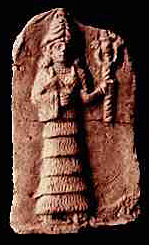 Kingship,
Inanna and the Tree of Life
Kingship,
Inanna and the Tree of Life
"When the
kingship was
lowered from heaven, the kingship was in Eridu" so says the Sumerian
King List. This is the root of divine rule. Mesopotamian kings
displayed their divine inheritance through symbols the most telling
being the branch from the Tree of Life. It all begins with Inanna.
There is no doubt of Inanna's connection to the Tree of Life. To the
far left she is shown holding a branch from the Tree of Life. This may
be the origin of the scepter. In the
Sumerian tale of Inanna
and Enki Inanna
travels to Eridu and visits with Enki. During her stay they drink beer
together and during this time Enki gives her the mes (pronounced
may) which
in this case includes the throne of kingship and kingship itself. It
became tradition that the king be ritually married to Inanna and earn
his divine right to rule. Thus we have the trapping of power derived
from
Inanna in the symbolism of the Tree of Life. Below are some examples
of this symbolism.





 Every
one of these images is of a king holding the symbol of the Tree of Life
by which he rules by divine right. The most popular is the three branch
style but all convey the same message. All kings also wear
the
bracelet with the rosette on it's band which is another symbol for
Inanna.
Every
one of these images is of a king holding the symbol of the Tree of Life
by which he rules by divine right. The most popular is the three branch
style but all convey the same message. All kings also wear
the
bracelet with the rosette on it's band which is another symbol for
Inanna.

In
the epic Enmerkar
and the lord of Aratta the king
of Uruk speaks to his messenger
who he is sending to Aratta:
"Messenger,
speak to the
lord of Aratta and say to him: "The base of my sceptre is the divine
power of magnificence. Its crown provides a protective shade over
Kulaba; under its spreading branches holy Inana refreshes herself in
the shrine E-ana. Let him snap off a splinter from it and hold that in
his hand; let him hold it in his hand like a string of cornelian beads,
a string of lapis lazuli beads. Let the lord of Aratta bring that
before me." So say to him." (lines 339--346) We see
written here
the connection of Inanna's scepter to the Tree of Life. The scepter is
the Tree of Life with its metaphor of spreading branches and thus its
divine power.
The
goddess Inanna/Ishtar
as Eve
One of
the most powerful concepts to come out of
Mesopotamia was that of divine kingship. The earliest records indicate
that "Kingship descended from heaven" and it was the Anunnaki that
claimed ruler ship over mankind and bestowed divinity upon the mortal
kings of the realm. However, the goddess Inanna is also intimately
involved with the bestowal of kingship. The true origin of Inanna is
not known by historians but she (as this site believes) is
based on the persona
of Eve. Why Eve? Adam and Eve were very powerful leaders in the
preliterate world. They were the
moving force in ancient Mesopotamia and their influence spread
throughout the region and out to the ancient world. Another possible
reason has to do with Cain. That story can be found on page Cain.
Inanna
is sometimes shown with a scepter the symbol of kingship. The scepter
is a representation of the Tree of Life just as is the caduceus.
If we look at the representations of the Tree of Life in Urartu we see
a scepter like shape resembling the scepter of Inanna. It is the
scepter that associates Inanna with Eve. The gods and goddesses of
ancient
time have fallen into myth shorn of their power but the scepter still
confers its power whether in royalty or the church. Even today in the
21st century this symbol from a time so remote, chronicled in the first
written words, still maintains its original meanings of divinity and
kingship.
Inanna wears the horned cap of divinity
as does Anu.
She is one of the gods in the Sumerian pantheon. Various symbols are
connected to her. The scepter, throne, a tree and a
snake and of these the scepter, crown, tiara, and staff are connected
to Anu. The rib story was borrowed from the Ninhursag saga a powerful
Nodite female goddess. "The
book of Genesis has more hints to this earlier epic [Atrahasis].
Ninhursag, who created the first "smarter humans" was celebrated by the
Anunaki and she was given the title of "Nin-ti," or "Lady of life."
Since early Hebrew has multiple meanings for the phrase "ti," meaning
both "rib" and "life," the creation of Eve by Nin-ti yielded to the
errant story of the first woman being created by Adam's rib (hence "the
lady of the rib")."
(http://www.viewzone.com/origins.html)
Inanna has an elusiveness of not being connected to a definite male figure although in some of the epics she is married to Dumuzi, the shepherd. I think that this is indicative of her original ascension in status to a goddess from the time after the ancient establishment of Eden. Eve has been placed in the Sumerian pantheon as Inanna, in the Assyrian pantheon as Aster and in the Egyptian pantheon as Isis. If we look at the symbol of Isis we see the ankh in which carries the root form of the scepter. In hieroglyphics the ankh simply meant "life". Even as Isis became Venus her scepter continues on perpetuating its power derived from a branch snapped from the Tree of Life originally grown in the soil of southern Mesopotamia.
"6. INANNA [ISHTAR], the highest ranking Goddess in the Pantheon, the Queen of Heaven. Her role transcended the bounds of the normal Pantheon, for she was not one the intruding Sumerian's divinities [emphasis added]. In the tale of Enki Ordering the Universe, Inanna grew angry as Enki announced the decrees called MES, assigning more than 160 Gods to their roles in the Universe. Inanna asked what he intended to give her, and he responded by giving her all that was left over. By way of this bequest, and as daughter of the Moon, Inanna took over the female related powers usually associated with the Moon. She became the Goddess of FERTILITY and of strong emotions such as LOVE and HATE.Inanna did not need Enki's permission to be All that she was. Her power to confer upon a human King the legitimate right to rule the whole valley as KING OF KISH is evidence of her strength, but it did not stem from Enki's bequest. Kings loyal to intrusive theologies found it necessary to undertake a Ritual Marriage to Inanna in her sacred precincts, and in her city of Uruk, in order to make their rule legitimate in the eyes of the valley community, and to authenticate their claim to rule by Divine Right. Inanna was a dangerous WIFE to the Kings of Kish; her range of Powers included Fortune, and its opposite. Inanna's power stemmed from the antiquity of her presence in the valley. Earlier agricultural residents of the valley engaged in orchardry, chiefly dates, as well as traditional grain and vegetable farming. Fruits and grains made year-round living in the valley possible because they were relatively easy to store for use in the fallow phases of the year. Long before the Sumerians and Akkadians entered the valley, the riverside dwellers had already evolved some enduring responses to the Life Forces involved in the Fruiting of plants and the Preservation of their produce. The Life Force which allowed plants to set fruit and thus provide sustenance to man and beast, was DUMUZI. It is likely that he had a dynamic connection to water, for his Domain lay in that portion of the valley which intermingled with the fertilizing waters of the Rivers. His consort/wife was Inanna. She was the fertile soil and the Spirit which guarded the Storehouse: the mother/protector of the produce of the land.
There are several layers of mythic symbolisms embedded in the rituals and stories about Dumuzi and Inanna. It is tempting to see Dumuzi as Sweet Water and Inanna as the fertilized and Spiritual Earth. But by historic times, Sweet Water was the Domain of Enki; Inanna had become the Queen of Heaven with enormous power; while Dumuzi had taken on much of the character of the Egyptian Horus without the Horus' divinity. Dumuzi was the Spiritual husband of Inanna who descended into the body of an earthly king during his ritual marriage to Inanna, a ritual which conferred upon the King the Divine Right to rule all he could conquer for so long as he could keep it."
(http://www.hallofmaat.com/maat/article.php?sid=63&page=1)

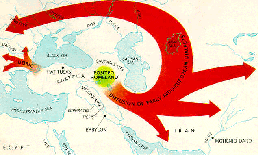
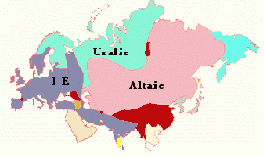 To
the left are three maps explaining the origin of the Indo-European
language. The first is the traditional view that the language had its
origin in a general area north of the Caucasus mountains between the
Black and Caspian Seas . From there people
speaking
the earliest Indo-European language migrated
both into Central Asia and Europe. The second map illustrates the
first migration of the language south into Iran, then north into
Central Asia
and finally turning back along the northern route into Europe. The last
map just shows the location the major language groups. Note that no
Indo-European is in Central Asia. Three quite different views on the
origins and spread of Indo-European speech. None of these views support
what the Urantia Book says and that is the Andites developed the
language and it's genesis is in Central Asia most likely in the
location now
called the BMAC.
To
the left are three maps explaining the origin of the Indo-European
language. The first is the traditional view that the language had its
origin in a general area north of the Caucasus mountains between the
Black and Caspian Seas . From there people
speaking
the earliest Indo-European language migrated
both into Central Asia and Europe. The second map illustrates the
first migration of the language south into Iran, then north into
Central Asia
and finally turning back along the northern route into Europe. The last
map just shows the location the major language groups. Note that no
Indo-European is in Central Asia. Three quite different views on the
origins and spread of Indo-European speech. None of these views support
what the Urantia Book says and that is the Andites developed the
language and it's genesis is in Central Asia most likely in the
location now
called the BMAC.
 For
a comparison, this map shows Andite expansion with a simplified map of
the silk road overlaid upon it. Not all routes are shown. It has a very
strong east to west orientation and most likely is our best guide to
earlier migrations. Between Bactria and the Tarmin Basin lie the Pamirs
also known as "the top of the world". Even here are examples of the
Tree of Life. The BMAC is shown in red. Language would follow the trade
routes.
For
a comparison, this map shows Andite expansion with a simplified map of
the silk road overlaid upon it. Not all routes are shown. It has a very
strong east to west orientation and most likely is our best guide to
earlier migrations. Between Bactria and the Tarmin Basin lie the Pamirs
also known as "the top of the world". Even here are examples of the
Tree of Life. The BMAC is shown in red. Language would follow the trade
routes.
Other
Symbols and Concepts Related to the Tree of Life
 Caduceus
Caduceus
"In
some cases the snakes seem to grow out of the top of the wand and this
seems undoubtedly a later form, related to the Greek caduceus
… When the evident connection between the coupled snakes and
the Tree of Life is considered and the substitution of the tree for the
caduceus by Assyrian art, one is driven to the conclusion that the wood
of the wand, so carefully detailed on the Gudea vase, is the trunk of
the Tree of Life.

It is
worth while remarking that the Winged Globe was sometimes borne as a
standard at the end of a staff …, in the manner of the
Caduceus and the Assyrian ensign."
(http://www.mythopedia.info/04-mesopotamia.htm)
"From a purely folkloric angle, it is impossible to ignore an odd fact that one finds in nearly every culture and throughout history: not only are staffs and serpents generally associated, but the juxtaposition or combination of the serpent and the bird symbols is almost always profoundly meaningful. That meaning, except in rare exceptions (which actually seem to prove the rule) is always positive, associated with healing, wisdom, and transcendence. The symbol of serpent and bird is typically reserved for powerful mythic figures, humans of unusual distinction (like shamans and mystics), or for royalty, who are often considered of divine origin.
Earlier,
in Sumerian and Akkadian representations of the axis mundi (the axis on
which the world spins), one finds a pair of serpents criss-crossed over
the rod."
(http://www.endicott-studio.com/forcaduc.html)
"The
oldest available evidence suggests that the caduceus comes from ancient
Sumer during the late 3rd millennium BC. A cylinder seal from 2,200 BC,
entitled The Serpent Lord Enthroned, shows the deity in human form
sitting on his throne before a smoldering altar bordered by caduceus
emblems, less the pole. Another seal from the late third millennium
reveals a male figure sitting on a throne. Opposite him is a female
figure, and between them, a tree heavily laden with fruit. Next to the
female figure, in familiar “S” pattern writhes the
serpent Nabu, the god of intellectual activity, wisdom and writing. In
the oldest recorded story known to mankind, The Epic of Gilgamesh, the
serpent springs from a well, eats the ‘plant of
youth’, sloughs off its skin and disappears again, robbing
the hero of his chance at immortality. Although no editorial provides
meaning for the snake’s theft of the plant, it is clear from
the story that the serpent became immortal by doing so, and Gilgamesh
did not. And finally at his death, Gilgamesh’s family and
friends weighed out their offering to the gods. And among them were
Ningizzida, the god of the serpent, the lord of the Tree of Life, to
whom they offered bread."
(http://www.sonsofgod-daughtersofmen.com/seccivil.htm)
Axis
Mundi and the World Tree
The Mayas
The axis
mundi
is a term for the center
or axis upon which the world revolves. It is a vertical column
connecting the heavens, the earthly plain and the underworld. In
Babylon Marduke's temple Ensagil was considered the location of the axis mundi. In other words Ensagil
represented the center of the world. Not only that but it was
constructed over the place where life originated and the first humans
were created (by Marduke). On this vertical column were also located
the heavenly temple of An and the underworld temple of Ea - three
temples aligned vertically upon one another. More interestingly the axis mundi is also
represented by the world tree or a sacred tree. This
tree was supposedly planted by Inanna. Previous to Babylon the axis mundi was resident at Nippur
whose god was Enlil one of the highest gods of the Sumerian pantheon.
This concept of a world tree has been copied into other cultures around
the world. The following quote is astounding considering it is from the
Mesoamerican Mayas:
"In
Mesoamerican theology, the world tree grew at the locus of creation,
all things flowing out from that spot into four directions. The tree
thus forms part of what Mircea Eliade refers to as the "symbolism of
the center." The center is, first and foremost, the point of "absolute
beginning," where the latent energies of the sacred world first comes
into being. 8 The source of all creation was often seen as a vertical
axis, or axis mundi, which stands at the center of the comos and passes
through each of the three major layers of existence - underworld,
terrettrial plane, and the sky.
On public
monuments, the oldest and most frequent manner in which the [Maya] king
was displayed was in the guise of the World Tree.... This Tree was the
conduit of communication between the supernatural world and the human
world. The souls of the dead fell into [the underworld] along its path;
the daily journeys of the sun, moon, planets, and stars followed its
trunk. The Vision Serpent symbolizing communion with the world of the
ancestors and the gods emerged into our world along it. The king was
this axis and pivot made flesh. He was the Tree of Life."
(http://64.233.167.104/search?q=cache:txJu3qFHgG8J:farms.byu.edu/getpdf.php%3Ffilename%
3DNjU5ODE1NzI0LTYtMS5wZGY%3D%26type%3DamJtcw%3D%3D+sacred+tree&hl=en&ie=UTF-8)
 There
is a famous sarcophagus lid with a classic Mayan image of the Mayan
king Pacal. On it the king is shown descending into the earth the
underworld. Directly above the king is the cross shaped Tree of Life.
There are many similarities between this Mayan Tree of Life and the
Mesopotamian Tree of Life. Both reference: the four cardinal points of
the compass, support the sky, have the three realms of sky (branches),
earth (trunk) and underworlds (roots). Both are the axis mundi
and the world tree. The Mayan cosmic tree was the conduit by which the
dead ascended to heaven and descended into the underworld. And as with
the Babylonian concept of kingship the Mayan was also seen as the very
embodiment of the axis
mundi. It was alive with sacred energy and had mirror
symbols indicating that the tree had a brilliance and power.
There
is a famous sarcophagus lid with a classic Mayan image of the Mayan
king Pacal. On it the king is shown descending into the earth the
underworld. Directly above the king is the cross shaped Tree of Life.
There are many similarities between this Mayan Tree of Life and the
Mesopotamian Tree of Life. Both reference: the four cardinal points of
the compass, support the sky, have the three realms of sky (branches),
earth (trunk) and underworlds (roots). Both are the axis mundi
and the world tree. The Mayan cosmic tree was the conduit by which the
dead ascended to heaven and descended into the underworld. And as with
the Babylonian concept of kingship the Mayan was also seen as the very
embodiment of the axis
mundi. It was alive with sacred energy and had mirror
symbols indicating that the tree had a brilliance and power.
"The
civilisations of Central and South America do not appear to have been
as ancient as those of Mesopotamia and Egypt, but there is plenty of
evidence to suggest that some cross-pollination of culture occurred,
possibly via such sea-faring nations as the Phoenicians, or even the
Sumerians. As amazing as it may seem, some artefacts that have been
unearthed in Bolivia, in the vicinity of Lake Titicaca, are inlaid with
cuneiform script that seems to be of Proto-Sumerian extraction (4).
This has lead some scholars to seek a controversial link between the
Mesopotamian culture 5000 years ago and South America.
We may
never know for
sure whether there is a basis for historical fact here, partly because
of the almost wholesale destruction of the indigenous cultures by the
Conquistadors, and partly because of the potential for hoaxed
archeological finds. Little has remained to enlighten academics and
archaeologists about the early mythological sources, and controversial
archaeological finds that run against the grain of orthodox thought
tend
to be side-lined or ignored by academics keen to maintain their
credibility. Then there was the purging of the Church. The genocide
that took part in those early days of European colonial conquest ran in
parallel with a purist drive to eradicate ancient pagan knowledge. Even
if the ancients of South and Central America knew of Nibiru, how could
we find out? "
(http://www.darkstar1.co.uk/inca.htm)

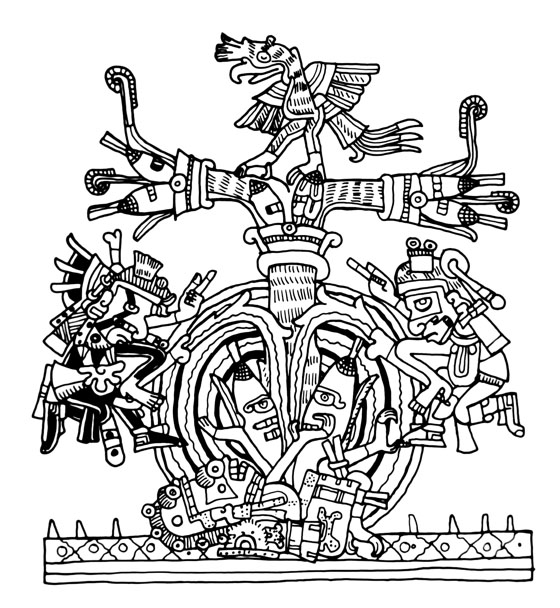 There
are more similarities between the Mayan and the Sumerian story of the
Tree of Life which includes the bird symbol that hovers above. In Sumer
this is the winged disk. In the Norse religion it is an eagle.
In the Mayan religion it is the Itzamna bird. This bird has a number of
names such as the Bird of Heaven, the Celestial Bird, the bird of the
upper world and the Principal Bird Deity. The illustration to the left
show the highly stylized Itzamna bird from the sarcophagus perched atop
the Tree of Life.
The B&W line drawing more easily shows the bird standing on the
Tree. Note the two genii
flanking the Tree of Life in true Mesopotamian style. From
the kneeling figures issue the
fresh waters just as the waters pour from Enki.
The
kneeling posture with the out reached hand can also be found in
Mesopotamian art.
Even the fruit is pine
cone shaped but is most likely based on maize just as it is represented
in east Indian art. At
the very
bottom is the god of death in the netherworld. Click
on both for a larger size.
There
are more similarities between the Mayan and the Sumerian story of the
Tree of Life which includes the bird symbol that hovers above. In Sumer
this is the winged disk. In the Norse religion it is an eagle.
In the Mayan religion it is the Itzamna bird. This bird has a number of
names such as the Bird of Heaven, the Celestial Bird, the bird of the
upper world and the Principal Bird Deity. The illustration to the left
show the highly stylized Itzamna bird from the sarcophagus perched atop
the Tree of Life.
The B&W line drawing more easily shows the bird standing on the
Tree. Note the two genii
flanking the Tree of Life in true Mesopotamian style. From
the kneeling figures issue the
fresh waters just as the waters pour from Enki.
The
kneeling posture with the out reached hand can also be found in
Mesopotamian art.
Even the fruit is pine
cone shaped but is most likely based on maize just as it is represented
in east Indian art. At
the very
bottom is the god of death in the netherworld. Click
on both for a larger size.

 "This
symbol is similar to those found in the murals of the ancient Mayan
city of Teotihuacan, Mexico depicting the "quetzal bird² with
a
sun-disk shield on the front of its body. The Quetzal symbolized the
movement of Creation and the will of the Creator come to
earth."
(http://www.f5ac.org/civicengagement/symbols.html)
"This
symbol is similar to those found in the murals of the ancient Mayan
city of Teotihuacan, Mexico depicting the "quetzal bird² with
a
sun-disk shield on the front of its body. The Quetzal symbolized the
movement of Creation and the will of the Creator come to
earth."
(http://www.f5ac.org/civicengagement/symbols.html)

 The
Mayan Tree of Life is a cross and carries the same symbolism as does
the Tree of Life in Mesopotamia. The cross to the left is of Inca
origin and although it may not look like the Tree of Life it does
represent many of the World Tree attributes. Included would be the four
cardinal points of the compass, the three levels of existence (the
heavens, the earth plane and the underworld) and the center hole being
the axis mundi with
its
association with the shaman's cosmic corridor and access to the gods.
This hole in the cross was also the portal for the soul to travel to
heaven and then down into the underworld to be reborn again. Also as
the axis mundi
it represents Cusco the heart of the Incan empire. It is known as the
Inca Cross and as the Chakana.
The
Mayan Tree of Life is a cross and carries the same symbolism as does
the Tree of Life in Mesopotamia. The cross to the left is of Inca
origin and although it may not look like the Tree of Life it does
represent many of the World Tree attributes. Included would be the four
cardinal points of the compass, the three levels of existence (the
heavens, the earth plane and the underworld) and the center hole being
the axis mundi with
its
association with the shaman's cosmic corridor and access to the gods.
This hole in the cross was also the portal for the soul to travel to
heaven and then down into the underworld to be reborn again. Also as
the axis mundi
it represents Cusco the heart of the Incan empire. It is known as the
Inca Cross and as the Chakana.
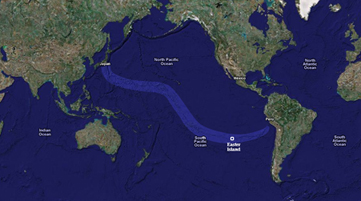 The Andites not only carried
civilization to Egypt but a small number
sailed to South America.
“One hundred and thirty two of this race, embarking in a
fleet of
small boats from Japan, eventually reached South America and by
intermarriage with the natives of the Andes established the ancestry of
the later rulers of the Incas.” (Urantia Book p.
873)
The Andites not only carried
civilization to Egypt but a small number
sailed to South America.
“One hundred and thirty two of this race, embarking in a
fleet of
small boats from Japan, eventually reached South America and by
intermarriage with the natives of the Andes established the ancestry of
the later rulers of the Incas.” (Urantia Book p.
873)
 Both
images are clickable. The larger one illustrates how the Andites set
sail from Japan and ended their journey in Peru. At the time of their
immigration sea levels were much lower and at that time many islands
dotted the Pacific. If you go to Google Maps you can easily see where
these islands were located. The smaller image shows where the earliest
known South American city, Caral, was built. Another interesting aspect
of this map is that the Nazca lines are just inland from the site where
the Andites arrived. About Caral:
Both
images are clickable. The larger one illustrates how the Andites set
sail from Japan and ended their journey in Peru. At the time of their
immigration sea levels were much lower and at that time many islands
dotted the Pacific. If you go to Google Maps you can easily see where
these islands were located. The smaller image shows where the earliest
known South American city, Caral, was built. Another interesting aspect
of this map is that the Nazca lines are just inland from the site where
the Andites arrived. About Caral:
"In 2001, the oldest town in South America was officially announced. Dating to 2600 BC, it pushed back the date for the “first town” with one millennium. What is even more intriguing, is that the town of Caral has pyramids, contemporary with the Egyptian Pyramid Era....The ancient pyramids of Caral predate the Inca civilisation by 4000 years, but were flourishing a century before the pyramids of Gizeh…What is Caral like? The site is in fact so old that it predates the ceramic period. Its importance resides in its domestication of plants, including cotton, beans, squashes and guava. The absence of ceramics meant that these foods could not be cooked – though roasting was an option....All pyramids were built in one or two phases, which means that there was a definitive plan in erecting these monuments. The design of the central plaza would also later be incorporated in all similar structures across the Andes in the millennia to come – thus showing that Caral was a true cradle of civilisation.
The
discovery of Caral has therefore reintroduced a powerful enigma: at the
same time, on two different continents, agricultural advancements
created a new style of life. The available workforce that agriculture
had created was reemployed in the construction of pyramids. This
“template” is visible in Peru, Sumer and Egypt, all
in the
3rd millennium BC. Coincidence, or evidence of design? Alternative
researchers will certainly soon reopen this debate, but archaeologists
steer well clear of it.
(http://www.philipcoppens.com/caral.html)
The other
ancient city above along with Caral is Chankillo and its claim to fame
is as the earliest solar observatory.
"At
Chankillo, not only
were there towers marking the sun's position throughout the year, but
they remain in place, and the site was constructed much earlier
–
in approximately the 4th century B.C.
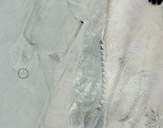 "Archaeological
research in Peru is constantly pushing back the origins of civilization
in the Americas," said Ivan Ghezzi, a graduate student in the
department of Anthropology at Yale University and lead author of the
paper. "In this case, the 2,300 year old solar observatory at Chankillo
is the earliest such structure identified and unlike all other sites
contains alignments that cover the entire solar year. It predates the
European conquests by 1,800 years and even precedes, by about 500
years, the monuments of similar purpose constructed by the Mayans in
Central America."
"Archaeological
research in Peru is constantly pushing back the origins of civilization
in the Americas," said Ivan Ghezzi, a graduate student in the
department of Anthropology at Yale University and lead author of the
paper. "In this case, the 2,300 year old solar observatory at Chankillo
is the earliest such structure identified and unlike all other sites
contains alignments that cover the entire solar year. It predates the
European conquests by 1,800 years and even precedes, by about 500
years, the monuments of similar purpose constructed by the Mayans in
Central America."
(http://www.eurekalert.org/pub_releases/2007-03/yu-pci030107.php)
Click on the image. The circle is the location of
the observation tower.
The solar markers are the backbone like ridge.

Norse
mythology and the
Yggdrasill
"Yggdrasill
is an Ash tree, at the centre of all worlds. It is the World Tree of
life and knowledge, and of time and space. On the highest branches sits
an eagle, and twisted round its roots lies a snake, gnawing at the
tree. The eagle and the snake hate each other. A squirrel runs up and
down the tree, telling each in turn what rude things the other is
saying!
Under the
roots of the tree there is a spring of water called Mimir. If you drink
from the spring, you will get wisdom and understanding. Odin thought it
was so important to be wise that he gave one of his eyes for a drink
from the spring. From that time on, he only had one eye, but he was the
cleverest of the gods. He invented Runes, the Nordic system of writing.
"
(http://www.gwydir.demon.co.uk/jo/nordic/yggdrasill.htm)
Textiles and the Tree of Life
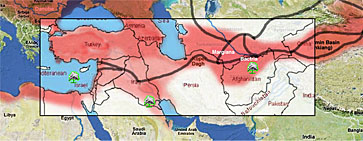 Rug and
Textile Design from Countries of the "Rug Belt"
Rug and
Textile Design from Countries of the "Rug Belt"
To
the left are the countries of the "Rug Belt". They stretch from modern
day Turkey to western China on a central path that follows the earliest
migrations of the Andites and the later appearing Silk Road. Within
these textiles we find examples of the Tree of Life, the serpent
(dragon) and the bird deity (phoenix). These images are from an ancient
Turkish culture and have shamanistic origins. They come from Central
Asia and a nomadic tradition. Most of Afghanistan and Turkmenistan are
included in
Central Asia.
"Rugs, like all other artifacts in traditional
societies, perform not
just utilitarian functions but store and transfer information on the
world-outlook o f their creators. Rugs like other kinds o cultural
texts (ritual, mythology, images, structures, etc.) retain archaic
features which tie the culture of the Turks of Asia Minor with Turkish
cultures [ethnic Turkic peoples] of other regions. These features
testify to their common sources. Traces of ancient beliefs reflected in
carpet patterns of the Turkish of Asia minor reveal their pre-Islamic,
shamanistic origin. Turkish prayer rugs (namzliks) were usually
intended to be a bridal dowry. Most of them are decorated with tree
patterns.
Turkic peoples are also aware of an ethno genetic myth about mankind
(Radlov, 1989, p 357) or as a shaman ancestor generating from a tree.
The name of the forefather is Odun. In modern Turkish languages, this
word means “firewood, log, timber”. In the
connection it is
tempting to draw a parallel between this name and the name of
”(W)odin, the head of the Scandinavian pantheon. The
shamanistic
character of this deity is beyond doubt. He is not only closely
connected with a tree (he gets the runes after hanging on a tree as a
sacrificial offer), he brings back to life the tree prototypes of the
first human beings."
(http://www.tcoletribalrugs.com/article11trees.html)
"Because
of this evolutionary shuffle the meanings of many symbols, motifs and
designs become lost and confused. The same iconography can mean very
different things to similar peoples. In spite of this there do remain
certain patterns that seem to survive this process. Some iconography
seems to hold universal value to these people who primarily express
themselves through woven textile arts.
Trees are a salient feature in the Middle East and Central Asia in
particular. Trees and forests feature heavily in art, literature and
myth. Frasers Golden Bough will convince anyone of the fertility aspect
of trees. They grow from the dust of Mother Earth and reach to the sky.
In fact trees and forests are often said to be the abode of gods or
possess supernatural powers. Fertility, an extremely common human
symbol dating into pre-history, is well and often represented by trees
in the form of growth and re-growth. "
 This
image is often called the Tree of Life and may be represented in a
variety of scales and pattern formations as well as flanked by a
variety of other floral symbols and animals. The entire ensemble can be
recorded to Sumerian times 3000 b.c.e. The probability these motifs are
included in our artistic collective memory is possible. Although the
rug pattern is indigenous to the Rug Belt, trees and the resulting
symbolism have played a role in many cultures around the globe. This is
conveyed via stories, myths, as well a pictorial representation in a
variety of art forms."
(http://www.antiquariusimports.com/lectures-symbols.php)
This
image is often called the Tree of Life and may be represented in a
variety of scales and pattern formations as well as flanked by a
variety of other floral symbols and animals. The entire ensemble can be
recorded to Sumerian times 3000 b.c.e. The probability these motifs are
included in our artistic collective memory is possible. Although the
rug pattern is indigenous to the Rug Belt, trees and the resulting
symbolism have played a role in many cultures around the globe. This is
conveyed via stories, myths, as well a pictorial representation in a
variety of art forms."
(http://www.antiquariusimports.com/lectures-symbols.php)

 The
Tree of Life design to the left is from a southern Iranian ethnic group
named the Baluch. Notice that this design resembles the vine tree
design found in Sumer and that the fruit at the ends of the
branch
also resemble the familiar football shape. It is quite interesting in
that most designs are more abstract in appearance. The Baluch tribe is
located in southern most Iran and adjacent to Pakistan where the
Andites entered India as Aryan invaders.
The
Tree of Life design to the left is from a southern Iranian ethnic group
named the Baluch. Notice that this design resembles the vine tree
design found in Sumer and that the fruit at the ends of the
branch
also resemble the familiar football shape. It is quite interesting in
that most designs are more abstract in appearance. The Baluch tribe is
located in southern most Iran and adjacent to Pakistan where the
Andites entered India as Aryan invaders.

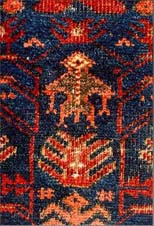 Another
Baluch design is this shaman within a tree. On the next page this
concept of the shaman/king/god within a tree is discussed. "Detail
of fig. 7 depicting a shamanic image contained within the trunk of the
tree. Seen holding trophies in either "hand", the arms appear more like
wings than arms."
(http://www.tcoletribalrugs.com/article15baluchstyle.html)
Another
Baluch design is this shaman within a tree. On the next page this
concept of the shaman/king/god within a tree is discussed. "Detail
of fig. 7 depicting a shamanic image contained within the trunk of the
tree. Seen holding trophies in either "hand", the arms appear more like
wings than arms."
(http://www.tcoletribalrugs.com/article15baluchstyle.html)
This
shamanistic concept
of the deity within a tree is a common theme. In the Siberian Ob-Ugrian
religion it is believed that the Shaman come from trees.
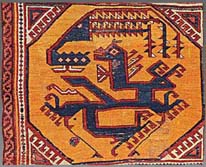 The Dragon &
Phoenix"The
image of the dragon and phoenix together, either in opposition or
simply confronting each other in the design pool of pile weaving is an
extremely old and archaic concept. This first image depicts an early
Anatolian weaving, circa 1400 AD, a well known image with a stylized
dragon on the bottom with an even more stylized phoenix above. (Fig.
39) The use of these dual images is well known in Tibet with these two
beasts, representing the male/female (Emperor/Empress) or yin/yang
aspects of life, cavorting with each other among the clouds."
The Dragon &
Phoenix"The
image of the dragon and phoenix together, either in opposition or
simply confronting each other in the design pool of pile weaving is an
extremely old and archaic concept. This first image depicts an early
Anatolian weaving, circa 1400 AD, a well known image with a stylized
dragon on the bottom with an even more stylized phoenix above. (Fig.
39) The use of these dual images is well known in Tibet with these two
beasts, representing the male/female (Emperor/Empress) or yin/yang
aspects of life, cavorting with each other among the clouds."
(http://www.tcoletribalrugs.com/article39SingaporePowerPt.html)

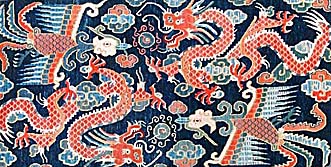 Another
image of the dragon vs. phoenix theme from Tibet. "A
Tibetan carpet depicting the ever popular dragon/phoenix design, a
pattern that is ubiquitous in Tibetan pile weaving. Early 20th century,
Collection of Shirin & Giuseppe de Giosa." The dragon and phoenix is
just another name for the serpent and bird conflict. Read the Sumerian
epic The Myth
of Etana for the background story.
Another
image of the dragon vs. phoenix theme from Tibet. "A
Tibetan carpet depicting the ever popular dragon/phoenix design, a
pattern that is ubiquitous in Tibetan pile weaving. Early 20th century,
Collection of Shirin & Giuseppe de Giosa." The dragon and phoenix is
just another name for the serpent and bird conflict. Read the Sumerian
epic The Myth
of Etana for the background story.
(http://www.tcoletribalrugs.com/article39SingaporePowerPt.html)

Hungary and the iconic
world tree
"The
"tree of life" or "world tree" is also a very common motif in Sumerian
and in many other traditions, but especially in the northern
Mesopotamian Hurrian religion. It is also common in many early
Shamanistic religions of the far north, as the connection between
heaven and earth and the axle of the world. It is beautifully
illustrated in a most Sumerian like form on a wall fresco, from the
royal hall of the old Hungarian king's castle in the city of Esztergom,
Hungary."
(http://users.cwnet.com/millenia/Sumer-origins.htm)
"The
heavely origin of kingship is already attested in the earliest
Mesopotamian cultures. In both Sumerian and Babylonian mythology, it is
expressed allegorically with the image of a
tree planted upon earth by the mother goddess, Inanna/Ishtar. The
sacred tree, usually represented in the form of a stylized palm tree
growing on a mountain, is the most common decorative motif in Assyrian
royal iconography.
A cosmic tree growing in the middle of the world and connecting heaven
with earth was the best imaginable visual symbol for the king's pivotal
position as the focal point of the imperial system and the sole
representative of god upon earth. When seated on his throne, the
king... merged with the tree, thus becoming, as it were, its human
incarnation. This idea is implicit in the fourth chapter of the
biblical book of Daniel, in which the king of Babylon dreams of a huge
tree growing in the middle of the earth, its top reaching the sky, and
it told by the prophet: 'That tree, O king, is you.' (Daniel 4:10-22)"
(http://www.cassiopaea.org/cass/grail_3.htm)
For more information on Hungary, the Tree of Life, Shamanism and the Hurrians see page The Vanites linked below.
Babylonian
"Stargate" the axis mundi
Babylon
was the location of the axis
mundi - the
center of the world or the
world axis.
"One of the
most powerful Babylonian myths is the concept of the axis mundi or else
known as the world axis, "navel of the world", the place of the
connection between heaven and earth. The story of the axis mundi is
chronicled in the Enumaelis [Enuma Elish] the so
called epic of world creation. After Marduk had defeated his foes he is
chosen by the gods to be their king. They erected a temple complex for
him in Babylon which was centered at the intersection of two
terrestrial axis with a central vertical cosmic axis that connects
heaven and earth. "The gods built their king's residence from which all
life ultimately originated and upon which Marduk himself was born and
all humans were created [a.k.a. Adam and Eve]." In the new year's
celebration of Marduk by the Babylonian kings, the yearly ceremony was
carried out on a "primeval hill". The king stood on a pedestal, the
locus of multidimensional cosmic cross hairs, in which he merged with
Marduk the king of the gods. Both flowed into one another in a moment
of prehistoric and present time, the mythical and the real, bound
together within the vertical cosmic axis at the center of creation.
"The Babylonian king then received from the hands of the gods the signs
of power, which were actually of the gods but now were his own."
"The
centripetal forces of the world-axis and the primeval hill not only
aided the Babylonian kingdom, but were among its essential supports,
State and kingdom understood themselves - as manifestly shown in the
rituals of the new years celebration - as a part of the cosmic order
which had been revealed to humans in the axis mundi."
(Paraphrased
and quoted from:
http://www.gatewaystobabylon.com/religion/ancientcapitals.htm)
"Sacred
space is understood as a split in the homogeneity of profane space;
this break builds an opening that allows a joint between separated
cosmic spheres, between heaven, earth and underworld: sacred space is
defined by this vertical dimension (axis mundi). The world is conceived
as an extension around this axis, respectively the axis mundi is
situated at the center of the world. The sacred mountain, the temple
and palace, the sacred city are always the axis mundi, the connection
of the cosmic dimensions. As center of the world, the sacred space
contains a replica of the whole cosmos, it represents heaven, earth and
underworld in a concrete form (imago mundi). Sacred space is the only
conceivable dimension of life. In Eliade's thought sacred space is
constantly connoted in an absolute positive way: it is cosmos, it is
withdrawn from the chaos by divine intervention: ..."
(http://www.cwru.edu/affil/GAIR/papers/2000papers/Daria.html)
"The
Enuma Elish is a Babylonian or Mesopotamian myth of creation recounting
the struggle between cosmic order and chaos. It is basically a myth of
the cycle of seasons. It is named after its opening words and was
recited on the fourth day of the ancient Babylonian New Year's
festival. The basic story exists in various forms in the area. This
version is written in Akkadian, an old Babylonian dialect, and stars
Marduk, the patron deity of the city of Babylon. A similar earlier
version in ancient Sumerian has Anu, Enil and Ninurta as the heroes,
suggesting that the story was adapted to justify the religious
practices in the cult of Marduk in Babylon."
( Dennis
Bratcher: http://www.cresourcei.org/enumaelish.html)
"Early
Sumerian and Akkadian artifacts (circa 2500 BC) show pictures of
a pole or tree which is called the "axis mundi " - the world
axis. It is the shaft that runs through and supports the
world. Guarding this tree or pole is a snake or pair of
intertwined snakes."
(http://searchenginez.com/2012/dragons2.html)
 The
Gudea Vase
The
Gudea Vase
"On
exhibit in the Louvre is a green libation vase, which was excavated
from the ancient Mesopotamian city of Lagash. The inscription
on it, from King Gudea of Lagash circa 2025 BC, is a dedication to
Ningizzida. Also on the vase is an image of two entwined
snakes on a rod. Some have dated the vase as far back as 4000
B.C. The rod is most likely to be Axis Mundi, the world tree,
Yggdrasil, the tree of life. Ningizzida, a fertility god, was
also known as 'Lord of the Tree of Life'. He was often
depicted as a serpent with a human head, and later became a god of
healing and magic. His companion was Tammuz/Dumuzi, who
personified the creative powers of spring [19] (like the Greek Maia)."
(http://survive2012.com/dragon_myths_5.php)
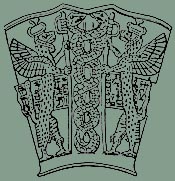 "The
Tree of Life had also been linked with the serpent or dragon (winged
serpent) for over 1,000 years before Genesis was written. In 2025 BC
the cup of the Sumerian King Gudea of Lagash (see Chapter 5, Fig. 22)
showed two winged dragons holding back a pair of opening doors to
reveal a caduceus of uniting snakes, the incarnation of the god
Ningizzida, one of the names given to the consort of the mother
goddess, to whom the cup is inscribed: ‘Lord of the Tree of
Truth’."
"The
Tree of Life had also been linked with the serpent or dragon (winged
serpent) for over 1,000 years before Genesis was written. In 2025 BC
the cup of the Sumerian King Gudea of Lagash (see Chapter 5, Fig. 22)
showed two winged dragons holding back a pair of opening doors to
reveal a caduceus of uniting snakes, the incarnation of the god
Ningizzida, one of the names given to the consort of the mother
goddess, to whom the cup is inscribed: ‘Lord of the Tree of
Truth’."
"In northern Babylonia the goddess of the Tree of Life was called the ‘divine Lady of Eden’ or Edin, and in the south she was called the ‘Lady of the Vine’, an understandable change of name given that the Sumerian sign for ‘life’ was originally a vine leaf.(10) However, in the myth of Eden, where there is no unifying image of a goddess, there is significantly also not one tree but two trees, or, it could be said, the one tree has become two, and now the fruit of both of them is forbidden. In earlier mythologies the one tree offered both ‘knowledge’ and ‘life’, or ‘wisdom’ and ‘immortality’ [as in Fig.1]. Here, knowledge of good and evil is split apart from eternal life, so that a perception of duality is rendered absolutely antithetical to a perception of life’s unity.(11) Campbell comments that: ‘The principle of mythic dissociation, by which God and his world, immortality and mortality, are set apart in the Bible is expressed in a dissociation of the Tree of Knowledge from the Tree of Immortal Life.’(12)" (http://mesopotamian-heritage.org/de_DE/2017/02/page/2/)
The above quote is interesting in that the same inscription on the Gudea vase has been translated in two different ways - Tree of Life/Tree of Truth. This may shed light on the problems of translation today. What this is saying is that both the Tree of Life and the Tree of Knowledge were one in the same. This is derived from the Genesis 2:9 account: "And out of the ground the Lord God made to grow every tree that is pleasant to the sight and good for food, the tree of life also in the midst of the garden, and the tree of the knowledge of good and evil". This statement is interpreted as both trees growing in the center of the garden. Since only one tree can actually occupy the center the second tree must be an additional attribute to the Tree of Life.
The
Mes
and Huluppu Tree
As
the above text demonstrates there is a question of was there one or two
trees in the garden. The question of the Tree of Knowledge can be
answered in my opinion by revisiting what the Sumerians wrote. The
Sumerian sacred tree must have had two names the mes (pronounced
may) and Huluppu. This
dichotomy of having two names for the same tree has resulted in
confusion regarding the Tree of Knowledge as a second tree.
The
Huluppu tree is mentioned in the Sumerian epic Inanna and the Huluppu
Treewhich
begins with a creation story and continues quickly on to Enki
planting the tree by the Euphrates River. Inanna finds the tree after
it was uprooted and plants it in her "holy garden." Later a bed and a
throne were fashioned for Inanna from the tree by Gilgamesh. The throne
and the
(marriage) bed are symbols of Inanna's domain of kingship. So the term
Huluppu was the name for the Tree as it relates to Inanna and would be
the Tree of Life.
In
the Sumerian epic Enki
and the World Order
the word usumgal is used to describe Enki which means "great serpent"
or "dragon." He plants the mes-tree
in Eridu. In ancient traditions the
serpent was considered wise and knowledgeable. "Be ye therefore as wise
as serpents..." (Matt 10:16) Enki's domain is in part
related to knowledge as in his being the keeper of the mes
- the decrees of civilization. His association with the sacred tree is
mainly that of the mes-tree.
I do not find it a coincidence that he is
associated with the mes
and the mes-tree.
It is the concept of the mes-tree
that has become the Tree of
Knowledge. Therefore the Huluppu and the mes-tree represent
the Tree of
Life in the Sumerian epics and both Enki and Inanna have legitimate
claims on in through two different cultures and time frames.
![]() The
picture to the left is Mayan. Within the oval is a human face which is
inside the mouth of a serpent. This serpent is known as the Vision
Serpent. The square inset is another example of this serpent. This
concept just on its own is quite extraordinary but what is included
with this sculpture makes it even more so. Click on the image for a
larger view. Included are the symbols for the sun god Shamash (with the
hub), the Goddess symbol of the rosette and the symbol for the moon.
Pure Mesopotamian
symbolism which is, of course, Andite. Except for the moon god Sin
these symbols of Inanna, Shamash/Utu, the serpent and Enki as the god
of knowledge all relate to Eden. This trail just does not seem to quit,
does it?
The
picture to the left is Mayan. Within the oval is a human face which is
inside the mouth of a serpent. This serpent is known as the Vision
Serpent. The square inset is another example of this serpent. This
concept just on its own is quite extraordinary but what is included
with this sculpture makes it even more so. Click on the image for a
larger view. Included are the symbols for the sun god Shamash (with the
hub), the Goddess symbol of the rosette and the symbol for the moon.
Pure Mesopotamian
symbolism which is, of course, Andite. Except for the moon god Sin
these symbols of Inanna, Shamash/Utu, the serpent and Enki as the god
of knowledge all relate to Eden. This trail just does not seem to quit,
does it?

Etymologists do not know what the mes-tree or the Huluppu tree actually means. Some of those who work with these epics comment that biblical accounts of this nature are based on the earlier Sumerian texts. That is these seemingly improbable stories are myth. This site sees it as that both biblical and Sumerian texts are referring to the same events, personalities and places in antiquity. That is these seemingly improbable stories are true.
The trail from Mesopotamia may also be found in the Andean mythologies of the Inca. The Inca worshiped the Earth goddess Pachamama and the sun god Inti with Viracocha as top creator god. The sun god Inti had a sister who was Mama-Kilya the moon. They also worshiped a feathered serpent god who was Viracocha and is also known to the Mayas as Kukulkan and Quetzalcoatl by the Aztecs. Other beliefs about this god would include the teaching of the arts of civilization, agriculture, the calendar and from the sea he came and to the sea he returned. The religious and social center of Inca life was in the large fortress called Sacsahuaman. It was home of the Inca Lord and the site of the Temple of the Sun. The Inca calendar was both solar and lunar. Mayan drawings of Kukulkan are said to resemble the Enki depictions from Sumeria. Within the Mayan pantheon he (as Kukulkan) was considered one of three gods who created the earth and was a twin brother to one of the other gods, Tezcatlipoca (his evil twin). The ancient Temple of Kukulkan of the Mexican Mayans is called El Castillo at Chichen Itza. This
image is from Bolivia and may relate to the allusion of Enki
Mesopotamian-like images of the Mayans. I have seen no images like
that. If they exist they do not seem to have been published. The metal
artifact is from the collection of Father Crespi in Ecuador. It is so
remarkable that it could be fake but that cannot be confirmed as it is
missing from the collection which is stored at the Central Bank of
Equador. But a ceremonial bowl from the area
of Lake Titicaca has proto Sumerian writing carved into it. The bowl is
called the Fuente Magna. The local Aymara language in Bolivia has a
number of root words considered as Semetic. (The Sumerians were not
Semetic but the Akkadians were. It was the Akkadians who first
conquered the Sumerians.) Artifacts can be faked but indigenous spoken
language cannot.
This
image is from Bolivia and may relate to the allusion of Enki
Mesopotamian-like images of the Mayans. I have seen no images like
that. If they exist they do not seem to have been published. The metal
artifact is from the collection of Father Crespi in Ecuador. It is so
remarkable that it could be fake but that cannot be confirmed as it is
missing from the collection which is stored at the Central Bank of
Equador. But a ceremonial bowl from the area
of Lake Titicaca has proto Sumerian writing carved into it. The bowl is
called the Fuente Magna. The local Aymara language in Bolivia has a
number of root words considered as Semetic. (The Sumerians were not
Semetic but the Akkadians were. It was the Akkadians who first
conquered the Sumerians.) Artifacts can be faked but indigenous spoken
language cannot. More on this subject can be found on http://www.atlantisbolivia.org/boliviaandthesumerianconnection.htm
Another site https://www.bibliotecapleyades.net/sitchin/sitchinbooks04_06.htm takes a different tact to this question of Sumerian visitation in terms of mining tin for the production of bronze. Although I am no fan of this site it still has some interesting things that contribute to this South American Sumerian/Andite mystery. The list of seemingly Mesopotamian influences continues to grow including religion, architecture, metallurgy, measurment, writing, art, language and legends.
The five holy symbols of Mesopotamia
They would be the moon god Nanna (Sin in Akkadian) a crescent shape, the sun god Utu (Shamash in Akkadian) as a star shape, the winged disk, the horned cap of divinity and a symbol for representing the Tree of Life. This Tree of Life symbol is sometimes represented as only two "branches" rather than the more familiar group of three. This symbol occurs within a variety of styles. Finally there is a symbol of 6 to 7 spheres that may represent the seven stars of the seven main gods (the Pleiades were thought to be the seven gods together as a group).
If you look closely at their winged disk in the picture below you will see a cross within a circle. This is the sign of Anu and perhaps some would claim the mark of Cain. It continues down to the present day. If you look at some of the Christian icons you will see the cross in the circle as in the halo of Christ. This particular halo is known as the Cruciform Halo.
![]()
![]()
![]()
These
holy symbols did not disappear with the ancient Assyrians. Two of them,
the star and the crescent moon are well known symbols today. They are
the symbols associated by westerners of Islam and is the motif in the
Turkish national flag. The star and crescent symbols were very potent
being pan-Mesopotamian and multicultural during those ancient times.
They are probably the two most important symbols, at least they are the
most enduring. The solar and lunar
cycles were very closely observed from deep within the Paleolithic and
measured by stone circles from the Neolithic.
The Cross in the Circle
"THE
SOLAR CROSS
the circular shape of the sun which emphasizes the ever recurring
cyclical nature of the seasons is the origin of this neolithic symbol.
It combines a cross within a circle and is the simplest conceivable
representation of the union of opposed polarities. probably the oldest
symbol in the world, it appeared in asian, american, european, and
indian art from the dawn of history."
(http://www.designboom.com/history/cross_2.html)
 "In
symbolic form, the Rosi-crucis [symbol for the holy grail] was the
original and longest standing mark of sovereignty – and this
is where the secondary Rosy Cross definition comes into play, for this
insignia was indeed a red cross within a ring. The early Bible writers
condemned this royal device as being the Mark of Cain."
"In
symbolic form, the Rosi-crucis [symbol for the holy grail] was the
original and longest standing mark of sovereignty – and this
is where the secondary Rosy Cross definition comes into play, for this
insignia was indeed a red cross within a ring. The early Bible writers
condemned this royal device as being the Mark of Cain."
(http://www.geocities.com/CapitolHill/Parliament/3460/lords1.html)
In the above statement, this mark being condemned by earlier Bible writers was not documented on the web site. No information was given as to where this statement came from. However, this same red cross is the symbol that the crusaders had emblazoned on their shields. This is part of the Merovigian kings myth of claiming they were part of the bloodline of Jesus through the lineage of Cain. Where ever the early church fathers encountered this symbol it may in fact be the "mark of Cain" or as I would put it the "mark of Eden". A mark put on Cain would be tribal and that would be Edenic. This would be a mark well understood by everyone within the vicinity. This is truly an old symbol from the time before recorded history. Actually I backed into this subject by investigating why Enki (Van) was connected with water. Here are the points I considered why water was important in connection with Enki "Lord Earth".
Enki's home is in the Abzu, the underground sweet water abode. It is also the location of his subterranean palace in the Axis Mundi, the pivot upon which the world turns. In the Babylonian epic Atrahasis it is where Marduke creates the first humans. Babylon was located in or very near the Garden of Eden.
Enki lives under the world tree in the Abzu from which his sweet water flows into the world.
Genesis 2:10
"Now there was a river issuing out of Eden to water the garden, and
from there it began to be parted and it became, as it were, four heads." Four
rivers flowed out of the Garden of Eden in which the Tree of Life grew
at its center.
"According
to Mesopotamian myths, the god of freshwaters, Enki, who dwells in the
freshwater abyss at Eridu, is the "single source" of all the world's
rivers,..."
(http://www.bibleorigins.net/DilmunMapsEriduUrSeaShorePersianGulf.html)
"Enki's
"Sea-house mansion" is shown [below] as a cubicle within the depths of
the imaginary freshwater ocean which lies under the earth. Note the
FOUR STREAMS surrounding this cubicle, showing it lies under water, in
the Abyss."
"Enki's
Sea-house or Abyss dwelling is located in e.din, at Eridu in
Sumer, where he has a fruit-tree garden by his
shrine,
which is worked by man which he has created to be an
agriculturalist to tend and till this garden, relieving the Igigi gods
of this toil at Eridu."
(http://www.homestead.com/bibleorigins*net/ApsuAbzuAbyssSeaHouseEnkiEaEridu.html)
"Enki then summoned Utu, the Sun God and Light of the Day. Together, they brought a mist from the depths of the earth and watered the whole face of the ground. Then Enki and Utu created waterways to surround the land with a never-ending source of fertile Sweet Waters, and Enki also devised basins and cisterns to store the waters for further needs. From these fertile sweet waters flow the four Great Rivers of the Ancient World, including the Tigris and the Euphrates." From the Sumerian myth ENKI AND NINHURSAG
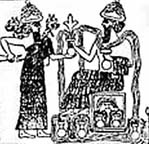
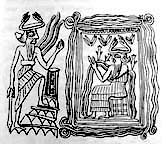
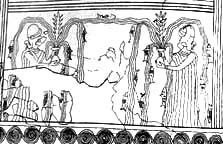
The above three images show Enki associated with four rivers. So how does all this relate to the "mark of Eden"? According to Sumerian mythology Enki is the source of all sweet water (as opposed to salt water). The water flows from Enki and in some images of Enki he is shown with four rivers flowing from him. He lives in the Abzu the source of his sweet waters. His temple is beneath the world tree. Genesis states water flowed from Eden into four rivers. The world tree is the axis mundi located at the center of a terrestrial "X". Four rivers therefore issue from the axis mundi which houses Enki's palace in the Abzu. The Sumerians pictured the world as a flat disk which was encircled by fresh water. This is the cross in a circle. The circle represents the Sumerian known world. The "X" represents both the location of the Axis Mundi at the center of the world as well as the four rivers from which all sweet waters originate. The Axis Mundi, the world tree, represents the Tree of Life that grew at the center of the Garden of Eden. Of all the gods of the Sumerian pantheon it is Enki who interacts the most with Inanna. And this is why I believe that the cross in the circle symbol is the "mark of Cain" or as I interpret it as the "mark of Eden". This symbol is still with us today. The image below is of a modern shaman's totem pole. Note the cross in the circle on the pole. This pole represents the axis mundi.
Click Here to return to Cain

 The image
to the left is very
interesting. It shows the Tree of Life with a serpent
wrapped around the trunk. Four rivers are issuing from the base of the
tree to a circle of water surrounding the illustration. At the bottom
is Enki's palace in the Abzu. You can click on the image for a larger
size. This is the only time I have seen all these elements in one
picture.
The image
to the left is very
interesting. It shows the Tree of Life with a serpent
wrapped around the trunk. Four rivers are issuing from the base of the
tree to a circle of water surrounding the illustration. At the bottom
is Enki's palace in the Abzu. You can click on the image for a larger
size. This is the only time I have seen all these elements in one
picture.(http://www.sacred-texts.com/earth/amm/amm07.htm)
The
illustration at the top of the page is a re-creation of a paneled
hallway from a palace in Urartu in which
hundreds of the iconic image
of the Tree of Life were painted in the same manner as the palace of
king Ashurnasirpal II and the later temple of king
Solomon.
 Back to Intro
Back to Intro The
First Legend Introduction
The
First Legend Introduction The
Tree of Life Heaven and Earth
The
Tree of Life Heaven and Earth Cain
Cain The
Vanites
The
Vanites